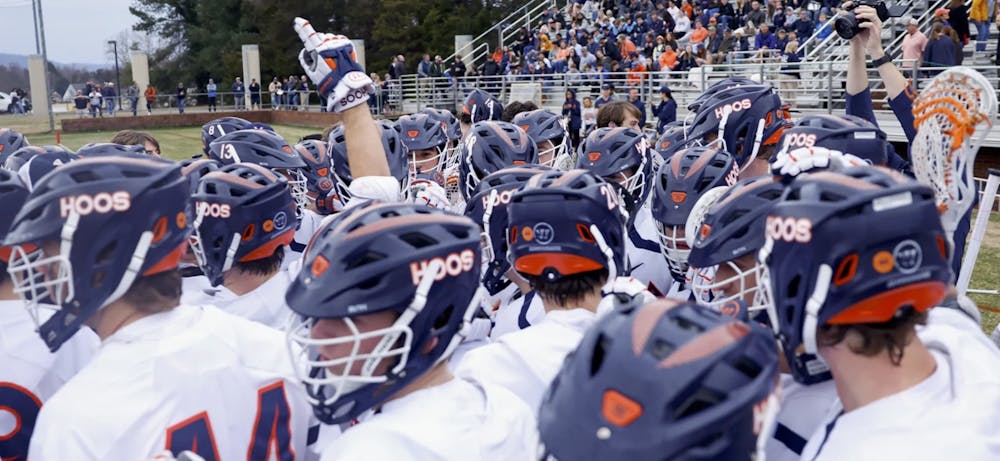A shadow has lingered over the men’s lacrosse program since longtime faceoff man Petey LaSalla departed to play professionally. But that shadow has recently receded, pushed aside by a rebuilt faceoff corps that has manufactured surprising success despite the departure of LaSalla, the program stalwart who manned the faceoff dot for five years.
“It’s a new era,” Coach Lars Tiffany said during his Wednesday media availability. “Not having just one faceoff guy take every faceoff. That was the plan the last few years here.”
The uncertainty surfaced during preseason as Virginia stared at a jumbled depth chart, filled with options who presented potential but had yet to prove themselves. The roster consisted of one returner, senior midfielder Gable Braun, who performed respectably in his limited appearances backing up LaSalla, and three transfers. Tiffany confessed his uncertainty during preseason.
“That is the most tenuous depth chart we have,” Tiffany said. “When you look at the faceoff X, [it’s] really unproven, across the board, and certainly unproven at the ACC.”
Two games in, though, after Virginia went 15-26 on faceoffs against Richmond, Tiffany sang a different tune. The faceoff went from a glaring weakness to a potential strength.
“We can win the ball at the faceoff X in the post-Petey LaSalla era,” Tiffany said.
It has been a fascinating experiment as Virginia seems now to have formed a firm faceoff formula, relying primarily on junior midfielder Anthony Ghobriel and on intimidating wing play. Ghobriel, a Navy transfer, quickly established himself as a force to be reckoned with. He shouldered the brunt of the load in the first two games and went 15-23 against Michigan and 15-24 against Richmond.
Ghobriel’s emergence slightly countered Tiffany’s expectations. Braun entered preseason as the tentative top guy, a returning player trusted by the coaching staff. But he sustained an injury in the preseason and missed the season’s first three games, then returned for the game against Johns Hopkins only to sustain another injury. Ghobriel has taken the bulk of the faceoffs in every game for which he has been healthy. He suffered a minor injury in the first half against Ohio State, missing the rest of that game and the following game against Johns Hopkins, but has since returned and resumed his dominant play.
“Anthony emerged after those first couple of games, with how much he was winning us the ball, more than 50-50 — which is something we didn’t know if we’d be able to realize this year — in many games,” Tiffany said. “But Anthony’s been consistent there.”
Ghobriel has won 60.5 percent of his faceoffs this season, a number identical to his win percentage at Navy last season. Transitioning from the Patriot League to the ACC and maintaining that percentage is an impressive feat, but he has had help. Virginia has battered its opponents so far this season with aggressive wing play, spearheaded by twin giants in sophomore midfielder Joey Terenzi and junior defenseman Ben Wayer. Tiffany routinely heaps praise on both.
“The real key has been our wings,” Tiffany said. “Ben Wayer and Joey Terenzi have been ferocious on ground balls. Our number of ground balls picked up by the actual faceoff men is too low.”
Virginia collectively averages 38.5 ground balls per game, the second-best mark in the nation. Wayer and Terenzi lead the brigade, and Tiffany’s descriptions of the pair seem boundless.
“He’s a man possessed,” Tiffany said of Wayer after the Ohio State game. “He’s like a mountain man coming down from the mountains after being gone for a year. And he is swinging a battle ax.”
While Ghobriel does take most of the faceoffs, graduate students Thomas Colucci, a Colgate transfer, and Matthew DeSouza, a Binghamton transfer, frequently contribute. Colucci has taken 47 faceoffs this season and DeSouza has taken 34, recording 55.3 and 44.1 percent clips, respectively. Ghobriel may be the unchallenged starter, but adding Colucci and DeSouza turns the faceoff committee into an adaptable machine.
Each of the three faceoff men is unique, armed with a different attribute. Ghobriel clamps stronger than the others, Tiffany said. DeSouza wields a more unique move, confusing opponents on the field. Colucci, meanwhile, adapts to his opponent, countering their best moves.
“It’s like throwing a lefty pitcher, a righty pitcher, a knuckleballer,” Tiffany said. “We’re just trying to keep our opponent from being too comfortable about knowing what’s coming.”
The entire faceoff machine will confront a formidable challenge come Saturday, when No. 4 Virginia travels to College Park, Md. to face rival No. 5 Maryland. In what will be a crucial matchup, the Terrapins boast one of the nation’s most dexterous faceoff men, graduate student Luke Wierman.
“It starts at the faceoff X,” Tiffany said. “And they’ve got one of the best in the country with Luke Wierman and his wing play.”
Wierman has won 63.4 percent of his faceoffs this season and presents a daunting challenge for Saturday’s game. But Virginia possesses intimidating wing play and a variety of faceoff talent, capped by a powerful top guy in Ghobriel. That could, against Maryland and in the future, turn the tide in favor of the Cavaliers.







